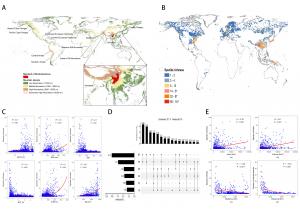Global patterns of Rhododendron diversity explained by island biogeography theory and habitat heterogeneity
USA, July 17, 2024 /EINPresswire.com/ -- • Global Rhododendron2 hotspots are mainly distributed in the Hengduan Mountains of southwestern China and the southern regions of the Himalayas.
• Rhododendron diversity patterns were most strongly explained by proxies of island biogeography theory (i.e., mountain area) and habitat heterogeneity (i.e., elevation range).
• The planimetric area and the volume of mountains were positively correlated with the Rhododendron diversity, whereas the ‘mountains-to-mainland’ distance was negatively correlated with Rhododendron diversity and shared species.
• Island biogeography theory and habitat heterogeneity jointly explain global patterns of Rhododendron diversity, and mountains can be regarded as islands which supported island biogeography theory.
Mountains are defined by their prominence, steep sides, and significant height above the surrounding regions. They harbor exceptionally high levels of biodiversity and a great number of endemic species worldwide, which are also extremely sensitive to the ongoing global climate change. Nevertheless, despite the importance of mountain biodiversity to biogeography and ecology, the underlying mechanisms that generate and maintain the biodiversity are not well understood.
Many hypotheses have been proposed to explain the large-scale distribution of species diversity, including those in the aspects of contemporary climate (environmental energy, water-energy dynamics and climate seasonality), historical climate change and habitat heterogeneity. Another theory is the island biogeography theory. Mountains are separated by lowland, just as 'true islands' are surrounded by water, and hence they have been referred to as 'islands on land'. However, it remains unclear whether these hypotheses explain observed diversity in mountain plant species, and whether the same factors maintain biodiversity on mountains and ‘true islands’.
In a study (https://doi.org/10.1016/j.pld.2024.03.0071) by Guangzhou University in China and University of Twente in the Netherlands, a team of researchers utilized Rhododendron — a large genus comprising more than 1000 species worldwide and a representative genus in mountain ecosystems — to explore the explanatory power of multiple hypotheses in explaining global pattern of Rhododendron diversity, as well as the applicability and extensibility of island biogeography theory when regarding mountains as islands.
“We found that Rhododendron hotspots are mainly distributed in the Hengduan Mountains of southwestern China and the southern regions of the Himalayas,” shares the study’s first author Yanwei Guan. “Regression analyses revealed the most influential predictor of global patterns of Rhododendron diversity was mountain area (MA), a proxy for the island biogeography theory.”
The second-best predictors of Rhododendron diversity patterns were proxies for habitat heterogeneity, that is, range of elevation (ELER) and range of mean annual temperature (MATR). Hierarchical partitioning also showed similar results that island biogeography theory explains the largest variance, followed by habitat heterogeneity.
“When we further examined whether the main tenants of island biogeography theory are all valid for mountain islands, we found that Rhododendron diversity was positively correlated with the planimetric area of mountains, and this correlation was significantly stronger between species diversity and volume of mountains,” adds Guan.
In contrast, Rhododendron diversity of each 'mountain island' was negatively correlated with isolation degree, the distance from the 'mainland'. The number of Rhododendron species shared between 'mountain islands' and the 'mainland' were also negatively correlated.
“Hence, island biogeography theory and habitat heterogeneity jointly explain global patterns of Rhododendron diversity, and mountains can be regarded as islands which supported island biogeography theory,” says Guan.
The team's findings, published in the KeAi journal Plant Diversity, offer critical insights into protecting Rhododendron diversity and strengthening mountain conservation.
DOI
10.1016/j.pld.2024.03.007
Original Source URL
https://doi.org/10.1016/j.pld.2024.03.0071
Funding information
This work was supported by the National Natural Science Foundation of China (NO. 41901060).
Lucy Wang
BioDesign Research
email us here
1 https://doi.org/10.1016/j.pld.2024.03.007
2 https://doi.org/10.1016/j.pld.2024.03.007

